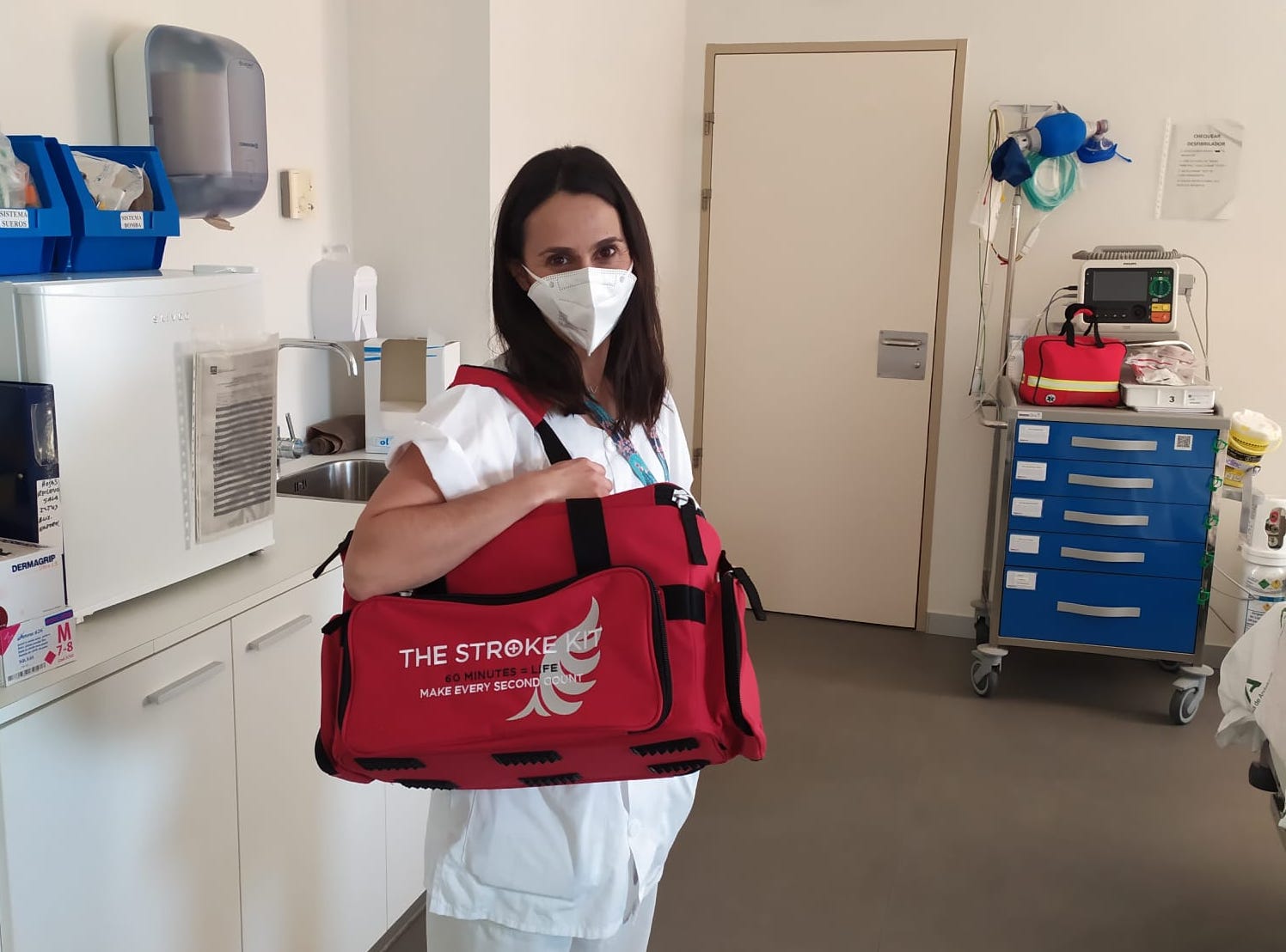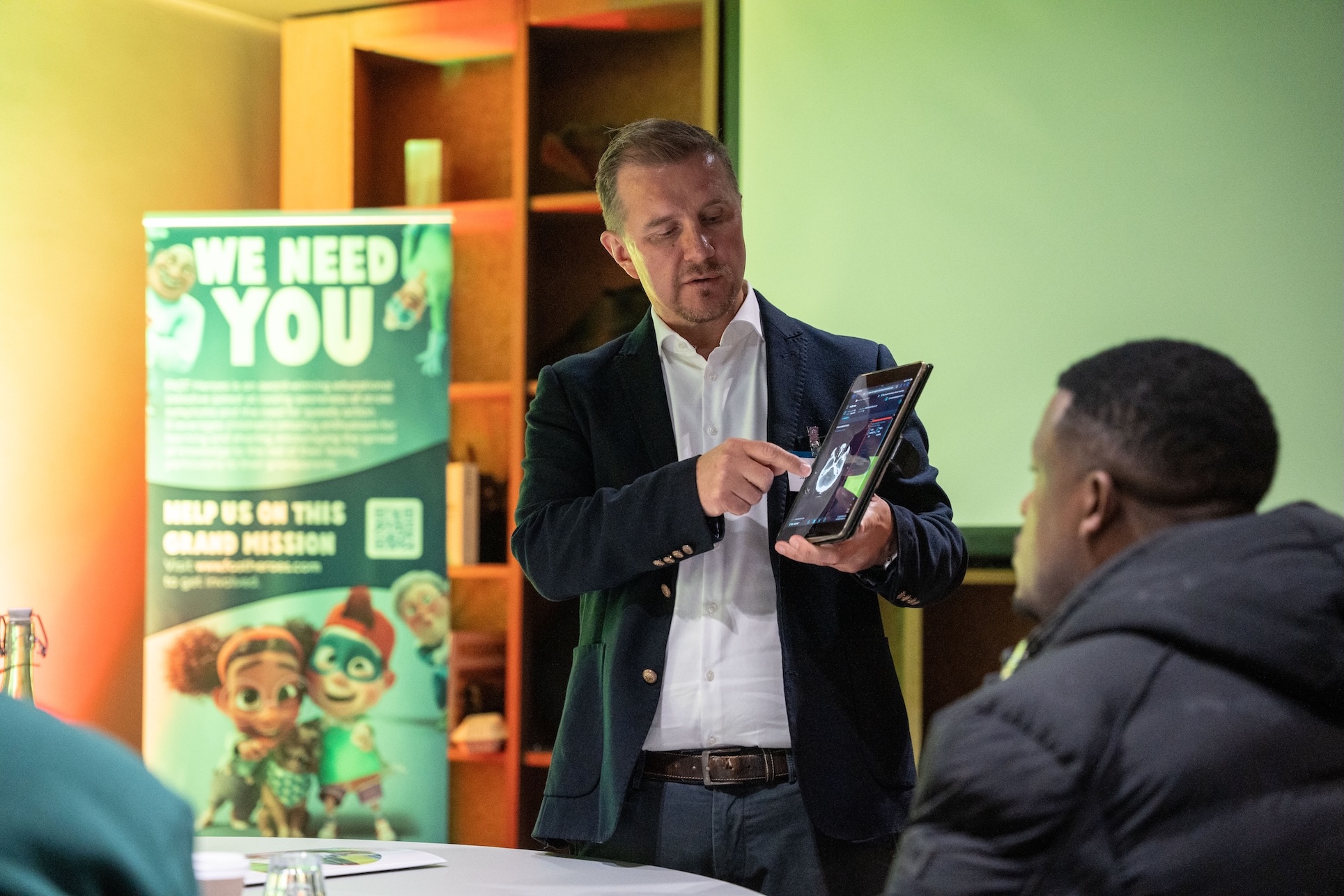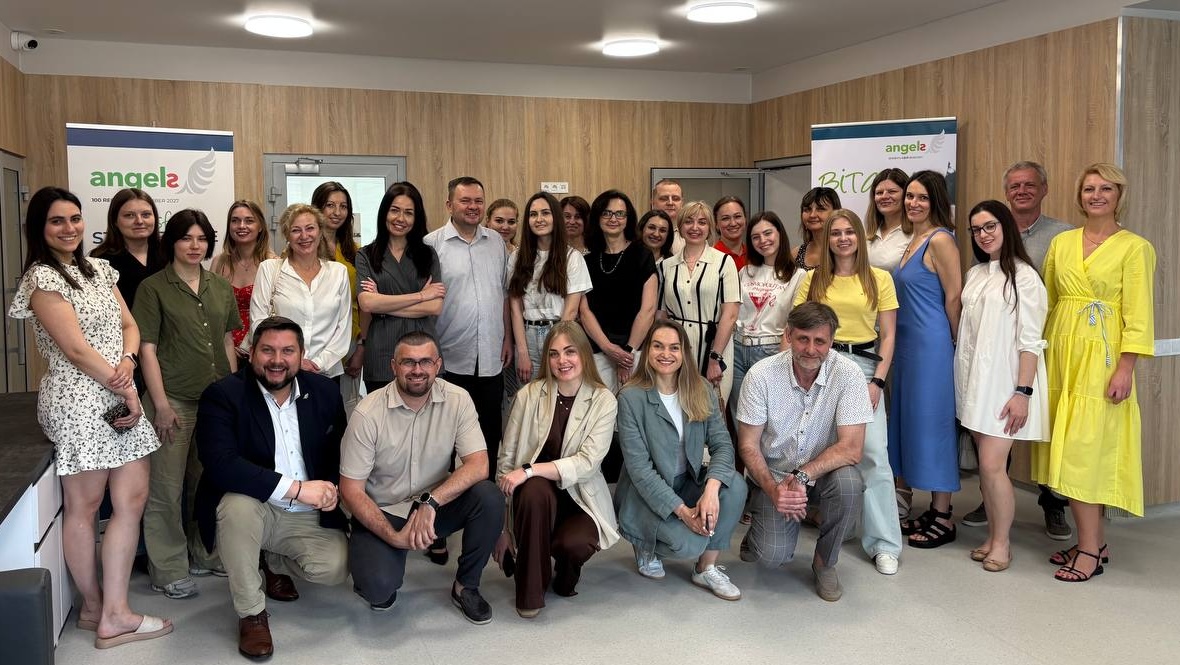
#1 SEVILLE | Nhà thần kinh học
Bệnh viện Universitario Virgen del Rocío ở Seville (HUVR) là bệnh viện lớn nhất và được cho là tốt nhất ở miền nam Tây Ban Nha và được biết đến cả trong và ngoài Tây Ban Nha về chất lượng nghiên cứu. Đây là nhà cung cấp dịch vụ cắt bỏ huyết khối cơ học số một của quốc gia này và là chất xúc tác cho sự xuất sắc trong chăm sóc đột quỵ trong khu vực, nơi nó đã giúp nhiều bệnh viện khác cải thiện con đường của họ.
Động cơ thúc đẩy sự xuất sắc nằm trong khung hình tinh gọn của nhà thần kinh học, Tiến sĩ Francisco “Pachi” Moniche, người nói về công việc của mình với tất cả cường độ mà bạn mong đợi ở một người có thời gian và một lần nữa quan sát thấy sự khác biệt giữa sự sống và tử vong. Anh ấy vẫn cảm nhận được điều đó một cách sâu sắc – khoảnh khắc khi quyết định đúng đắn vào đúng thời điểm thay đổi cuộc sống của ai đó. Trên thực tế, ông đã nói với cư dân của mình rằng nếu ông không còn cảm xúc khi nhìn thấy một bệnh nhân đột quỵ lấy lại khả năng nói chuyện và di chuyển của họ, họ nên khuyên ông bỏ thuốc lá.
Bác sĩ Pachi Moniche không có nguy cơ sớm bỏ thuốc. Là một bác sĩ thần kinh trong 16 năm qua, ông biết ngay từ khi bắt đầu cư trú rằng đột quỵ là điều mà ông gọi là “phần tốt nhất”. Với các bệnh thoái hóa như đa xơ cứng hoặc Parkinson, bác sĩ có thể thử bảo tồn và cải thiện chất lượng cuộc sống của bệnh nhân. Nhưng bằng cách điều trị đột quỵ, quý vị có thể trả lại mạng sống cho ai đó – và đó là điều mà bác sĩ này không thể có đủ.
Giống như ở nhiều bệnh viện thuộc thế hệ của nó, có khoảng cách đáng kể để phân tách chụp X-quang, cấp cứu và đơn vị đột quỵ tại HUVR. Nhưng thông báo trước viện của dịch vụ xe cứu thương có nghĩa là đội đột quỵ có thể gặp bệnh nhân ở lối vào và thu thập thông tin liên quan từ nhóm xe cứu thương và tiến hành đánh giá bệnh nhân theo NIHSS khi họ được đưa trực tiếp đến phòng CT.
Trước đây, họ đã chuyển bệnh nhân đến khoa cấp cứu để điều trị, Tiến sĩ Moniche nói. “Nhưng chúng tôi nhận ra mình đang mất thời gian.”
Xác định đúng người để điều trị cho bệnh nhân khi chụp CT là vấn đề về hậu cần và DNA của nhân viên. Đơn vị điều trị đột quỵ ở quá xa và chỉ có một điều dưỡng điều trị đột quỵ đang làm nhiệm vụ, phòng bệnh sẽ không được giám sát. X-quang không thích rủi ro. Sau đó, bác sĩ Pachi nhìn vào gương và tìm thấy chính xác người mà ông đang tìm kiếm.
Việc tự tiêm thuốc tiêu huyết khối không có trong sách hướng dẫn của mọi bác sĩ thần kinh. Một số người khăng khăng đòi hỏi một môi trường thông thường hơn với các y tá và giám sát viên có mặt ngay cả khi điều đó có nghĩa là phải chịu một chút chậm trễ. Nhưng trì hoãn một phép màu không nằm trong DNA của Tiến sĩ Moniche. Ông cũng không thể đồng ý với bác sĩ thần kinh, người tại một hội thảo trên web gần đây đã bày tỏ quan điểm rằng bằng cách thực hiện một nhiệm vụ thường được giao cho các y tá, Bác sĩ Moniche đã phá hoại tinh thần đồng đội.
Dù sao anh ấy cũng không hiểu về làm việc nhóm. Ngược lại. “Khi tất cả các bạn cùng nhau đẩy một con cáng, đó là làm việc như một nhóm”, ông nói. “Điều quan trọng nhất là bệnh nhân và không ai là quá quan trọng để giúp đỡ.”
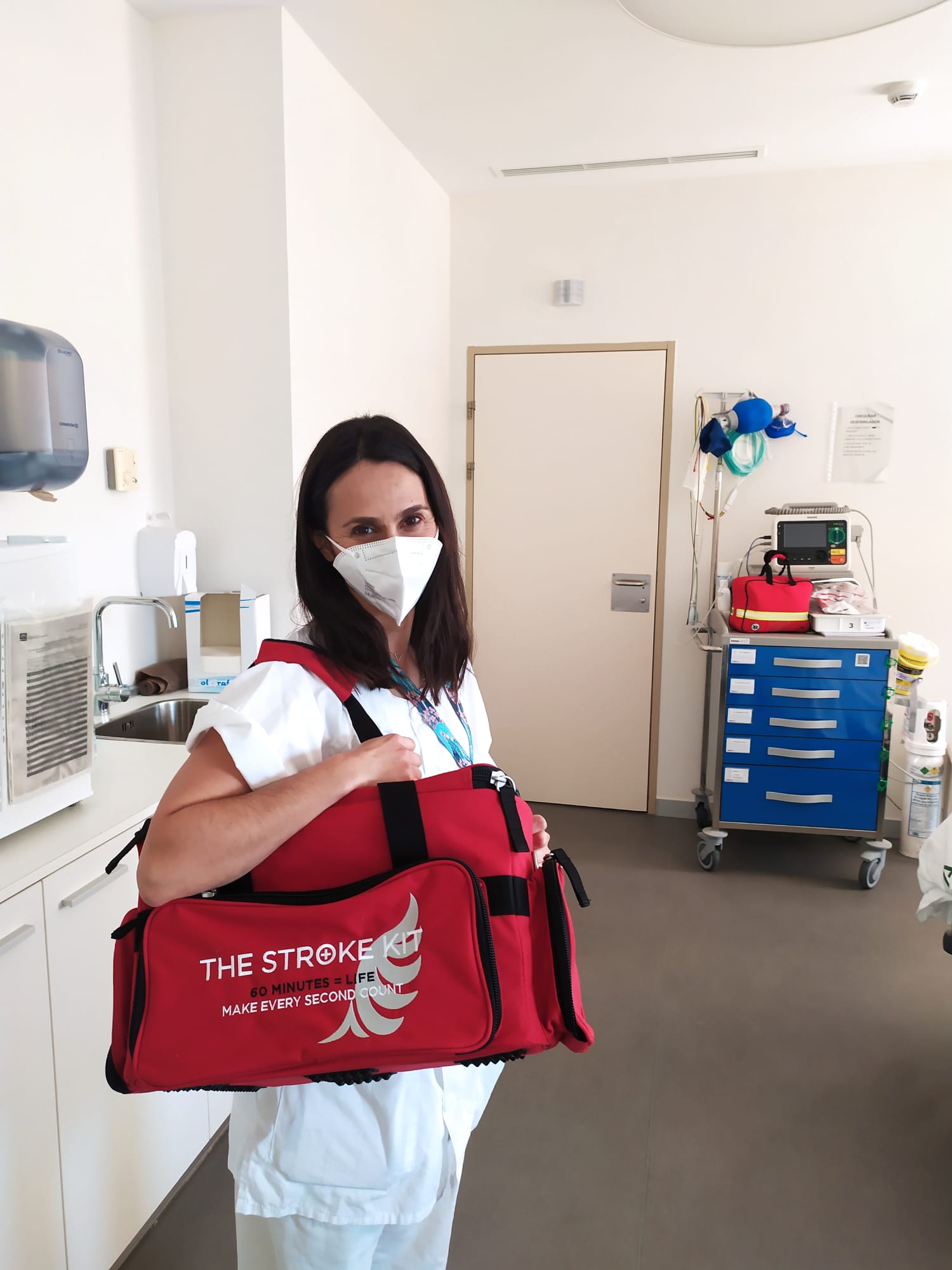
#2 MÁLAGA | Điều điều dưỡng đột quỵ
Đơn vị đột quỵ tại Bệnh viện Đại học Virgen de la Victoria ở Málaga nằm trên tầng bốn, đi thang máy và đi bộ nhanh từ phòng chụp CT nằm ở tầng trệt gần khoa cấp cứu. Đó là một tuyến đường mà Paloma Caro biết rất rõ.
Khi một bệnh nhân đột quỵ được đưa đến bệnh viện, chính cô ấy là người sẽ đi xuống cầu thang, tốc độ của cô ấy nhanh hơn bởi một cơn sốt dự đoán và lo lắng quen thuộc.
Paloma không nhớ chính xác lý do tại sao cô ấy chọn điều dưỡng 20 năm trước nhưng cô ấy nhớ rất rõ khi khoa thần kinh chọn cô ấy. Ngay từ đầu sự nghiệp của mình, cô đã phải vật lộn để tìm đường, nảy ra giữa các thành phố và các đặc sản.
“Rồi đột nhiên, trải nghiệm lớn của tôi – một năm làm tình nguyện viên ở Cộng hòa Dominica và Haiti, giữa trận động đất thảm khốc năm 2010.”
Trở về Tây Ban Nha và gần đây đã tốt nghiệp Thạc sĩ Y tế Quốc tế, phải mất thêm vài năm nữa để khoa thần kinh tìm được cô. Nhưng cuối cùng, cô cảm thấy được ghi nhận – và bây giờ là cá nhân, cô nói. “Không chỉ với tư cách là một điều dưỡng mà còn với tư cách là một phụ nữ – tôi cảm thấy rằng mọi thứ liên quan đến đột quỵ đều xứng đáng với thời gian của tôi”.
Cô gia nhập đơn vị đột quỵ tại Virgen de la Victoria khi mở cửa vào năm 2018 và Tiêu huyết khối vẫn còn mới trong trí nhớ của cô:
“Tất cả mọi người trong nhóm đều lo lắng, đây là lần đầu tiên một số người trong chúng tôi cảm thấy lo lắng. Trên đường đi, tôi đã nghĩ về liều lượng, tác dụng phụ, tín hiệu khẩn cấp, giới hạn huyết áp... Tiếp theo tôi nghe bác sĩ yêu cầu tôi chuẩn bị thuốc Tiêu huyết khối. Tôi nhớ đôi mắt của bệnh nhân. Anh ấy không thể nói chuyện khi đến nhưng sau vài phút, anh ấy bắt đầu hét lên, ‘Này, nghe này, lại là giọng nói của tôi!’ Tôi cảm thấy mình là một pháp sư và nhớ rằng tôi đã cảm ơn khoa học vì đã biến điều đó thành hiện thực.”
Paloma nói: “Y điều dưỡng điều dưỡng đột quỵ đi chụp CT có lẽ là một trong những ví dụ tốt nhất về ý nghĩa của ‘làm việc theo nhóm’”. “Chúng tôi tham gia vào toàn bộ quá trình và chúng tôi hiểu trách nhiệm của mình. Đồng thời các bác sĩ thần kinh hiện đang gần gũi hơn, giao tiếp tốt hơn và chúng tôi cảm thấy được tôn trọng hơn, vì vậy mối quan hệ mạnh mẽ hơn.
“Giữa các y tá trong đơn vị đột quỵ, làm việc nhóm cũng rất quan trọng, bởi vì nếu đồng nghiệp của bạn đi chụp CT, bạn chịu trách nhiệm cho bệnh nhân ‘cô ấy’, vì vậy từ khi bắt đầu mỗi ca làm việc, chúng tôi làm việc cùng nhau.”
Cam kết của Paloma đối với việc chăm sóc đột quỵ đã thúc đẩy cô vào vai trò lãnh đạo không chính thức tại bệnh viện của cô. “Tôi chỉ muốn chia sẻ kiến thức và sự nhiệt tình của mình với các đồng nghiệp với mục tiêu bệnh nhân phải luôn nhận được sự chăm sóc tốt nhất có thể, bất kể ai đang làm nhiệm vụ.”
Khi cô về nhà vào cuối ca làm việc bận rộn, thường để đốt dầu lúc nửa đêm khi cô làm việc trong các nghiên cứu tiến sĩ của mình, cô thích thú khi biết rằng nhóm đã làm hết sức mình và mọi người đều cảm thấy có giá trị và được công nhận. “Đó là một cảm giác tuyệt vời.”
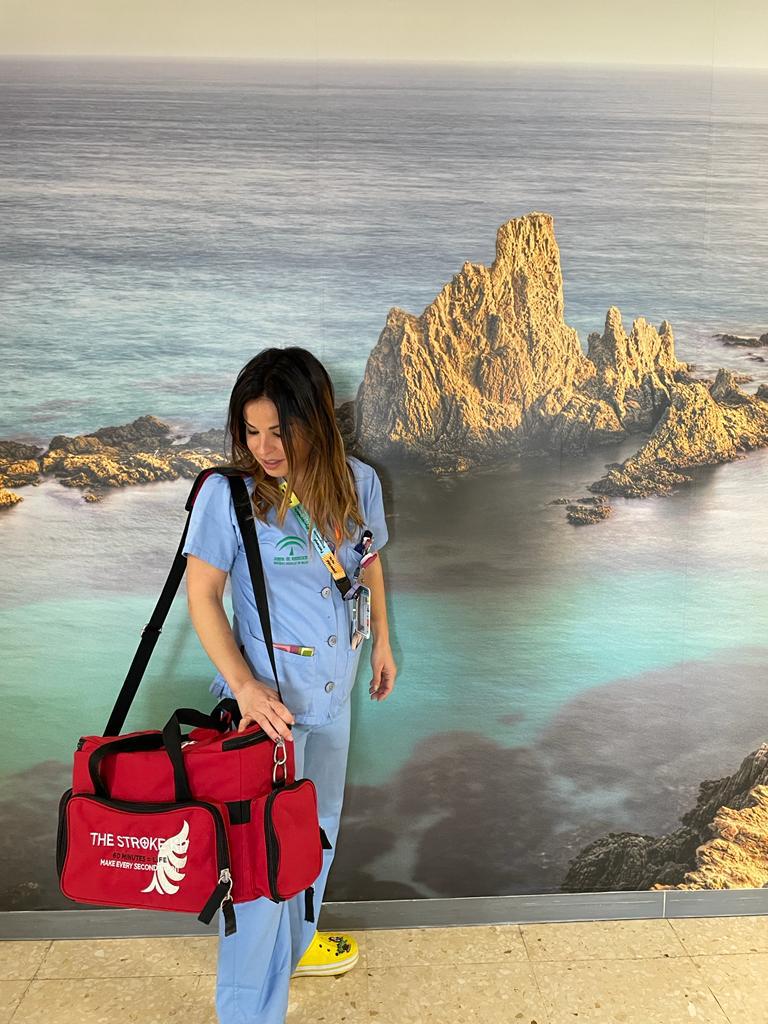
#3 ALMERIA | Y điều dưỡng ED
Bệnh viện Đại học Torrecárdenas ở Almería sẽ sớm nhận được giải thưởng kim cương ESO Angels thứ hai, một phần thưởng phù hợp cho sự tập trung cải thiện đã chứng kiến thời gian giao hàng tận nơi của họ giảm xuống dưới 45 phút cho 80% bệnh nhân và tỷ lệ tái phẫu thuật của họ đạt 34%. Điều trị cho bệnh nhân của họ khi chụp CT là một hành động ưu tiên quan trọng mà họ đã thực hiện ngay từ đầu.
Con đường đột quỵ tại Bệnh viện Torrecárdenas là một nghiên cứu về logic. Khi nghi ngờ đột quỵ, EMS báo trước cho cả bác sĩ thần kinh và khoa cấp cứu (ED) là những người cảnh báo X quang lần lượt. Bệnh nhân được gặp ở lối vào và được đưa qua một khoảng dừng ngắn trong khu vực quan trọng ED đến phòng chụp CT ở tầng trệt. Sau khi điều trị bằng Tiêu huyết khối, họ được đưa vào đơn vị đột quỵ hoặc, nếu họ cũng là ứng viên cho phẫu thuật cắt bỏ huyết khối, đến phòng can thiệp thần kinh ngay gần kề.
Sử dụng thuốc tiêu huyết khối là trách nhiệm của Mari Paz Fernández, một điều dưỡng ED được ghi nhận về cách tiếp cận chủ động và cam kết với bệnh nhân của mình. Sau 17 năm làm điều dưỡng, cô đã học được cách không để công việc của mình phá hoại cảm xúc của mình, nhưng đột quỵ có thể là ngoại lệ.
“Stroke đánh dấu bạn”, cô nói. “Bạn sợ rằng điều đó có thể xảy ra với người bạn yêu thương, vì vậy bạn cố gắng hơn nữa để đảm bảo bệnh nhân nhận được sự chăm sóc tốt nhất và có thể mong đợi một cuộc sống chất lượng.”
Cô nói, chính những bậc cha mẹ trẻ ảnh hưởng đến cô nhiều nhất, nhớ lại một phụ nữ 40 tuổi bị liệt nửa người bên phải. “Tuổi tác của chúng tôi tương tự nhau và tôi thấy bản thân được phản ánh trong cô ấy. Điều đó khiến tôi choáng ngợp khi nghĩ rằng mình có thể là người phụ nữ đó.”
Tuy nhiên, ngay khi Mari dùng bolus, cô thấy nước mắt hình thành trong mắt bệnh nhân và cảm thấy cô bóp chặt tay. Cô ấy nói, “Cảm giác khi ai đó cảm ơn bạn chỉ đang nhìn bạn – điều đó ở lại với bạn mãi mãi.”
Mari lớn lên khi biết rằng cô muốn làm việc trong lĩnh vực chăm sóc sức khỏe và chọn điều dưỡng vì điều đó có nghĩa là có nhiều thời gian hơn với bệnh nhân. Kinh nghiệm của cô bao gồm làm việc trong EMS, điều này đã mang lại cho cô cái nhìn sâu sắc có giá trị về giao diện giữa các giai đoạn trước bệnh viện và trong bệnh viện và tầm quan trọng của sự phối hợp giữa các nhóm.
Cô yêu công việc của mình vì không có hai ngày nào giống nhau và cô thấy nhân loại ở trạng thái tốt nhất và kém nhất. Trở thành một phần của một nhóm cứu mạng sống cảm thấy vô cùng tuyệt vời, cô nói.
Chịu trách nhiệm về việc Tiêu huyết khối như một điều dưỡng cấp cứu có ý nghĩa hoàn hảo, cô tin rằng. “Sau cùng, đột quỵ là một trường hợp cấp cứu.”
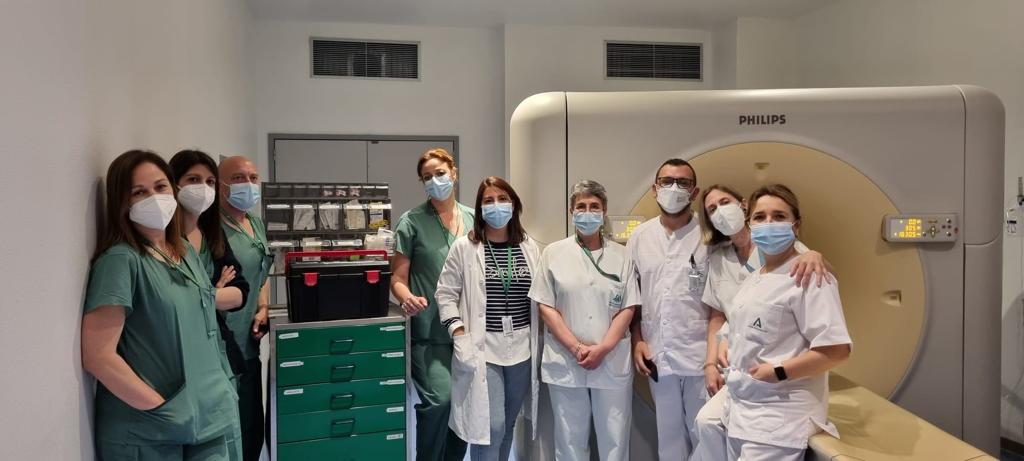
#4 GRANADA | Y điều dưỡng chụp X-quang
Đó là công việc của một thời điểm để thay đổi tư duy. Estefanía Terrón, giám sát viên chụp X-quang tại Bệnh viện Đại học San Cecilio ở Granada, nhớ lại khoảnh khắc như vậy. Điều này xảy ra khá sớm sau khi đề phác đồ đột quỵ tại bệnh viện của cô ấy được thay đổi và nhiệm vụ tiêm thuốc tiêu huyết khối được chỉ định cho nhóm của cô ấy. Trong trường hợp này, bác sĩ thần kinh đã gặp khó khăn để cảm ơn và chúc mừng nhóm điều dưỡng X quang về công việc tuyệt vời của họ và chia sẻ tin tức rằng bệnh nhân đang hồi phục nhanh chóng.
“Y điều dưỡng đã cho dùng liều bolus chạy để nói với các đồng nghiệp của mình và nhận ra rằng vai trò của họ là quan trọng dẫn đến nước mắt.”
Sau đó họ là một nhóm khác.
Estefanía thể hiện hai đặc điểm thu hút mọi người đến với sự nghiệp trong ngành điều dưỡng - lòng can đảm và mong muốn giúp đỡ người khác. Cả hai
thuộc tính là lý do cô ấy nói “có” hai năm trước, khi, như một phần của dự án phát triển phác đồ đột quỵ và cải thiện thời gian điều trị của họ, lựa chọn điều trị bằng CT đã được trình bày cho tất cả các dịch vụ liên quan đến mã đột quỵ.
Estefanía nói, nhóm của cô ấy sẽ làm điều đó.
Trước đây điều trị đã diễn ra trong ICU, nhưng với phòng CT nằm ngay trong khoa cấp cứu, phác đồ mới là một yếu tố thay đổi trò chơi tiềm năng mà cuối cùng sẽ giảm thời gian từ cửa đến kim trung bình xuống dưới 35 phút.
Estefanía nói: “Chúng tôi biết từ các nghiên cứu rằng điều này là tốt nhất cho bệnh nhân”. Cô ấy không nghĩ hai lần về việc giơ tay lên.
Cơ hội đưa ra quyết định vì lợi ích của bệnh nhân là một trong những điều cô ấy yêu thích trong công việc của mình. Từ khi còn nhỏ, cô đã biết rằng cho con bú là số phận của mình, nhưng với tư cách là y điều dưỡng trong khoa cấp cứu và EMS, cô đã phát hiện ra tiếng gọi thực sự của mình. Làm việc trong một môi trường cấp cứu nuôi dưỡng niềm tin của cô vào làm việc nhóm; sau đó đột quỵ và tầm quan trọng quan trọng của thời gian trong chăm sóc đột quỵ dẫn đến chụp X-quang, nơi cô nhanh chóng phân biệt mình là một nhà lãnh đạo.
Estefanía nói rằng thay đổi luôn khó khăn, nhưng bạn có thể vượt qua nỗi sợ hãi bằng cách tập trung vào việc cung cấp dịch vụ chăm sóc chất lượng cho bệnh nhân. “Điều quan trọng là sự đồng cảm và đặt mình vào vị trí của bệnh nhân. Tôi luôn nói với các đồng nghiệp của mình, ‘Nếu bệnh nhân là cha tôi, tôi muốn nhóm hành động như thế nào?’”
